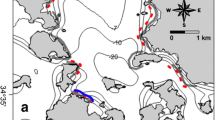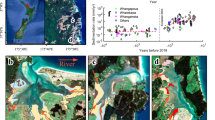Abstract
Reed Canarygrass (RCG) is an aggressive invader in aquatic ecosystems that swiftly modifies the environment, resulting in biodiversity loss and reduced flood conveyance. However, because so little research has been conducted on RCG along riverbanks and islands, the mechanism by which it so rapidly colonizes rivers is not well understood. This study examined how colonization of RCG, via the expansion of an individual patch through wake deposition, may be driven by differences in flow depths. A set of mobile-bed experiments were conducted in a physical model to examine the influence of submergence depth on wake characteristics and deposition around a mid-channel, emergent patch of flexible RCG. At low submergence (31%) depths, low wake velocities promoted streamlined deposition behind the patch that is associated with longitudinal patch expansion. At deeper submergence (75%) depths, the introduction of vertical shear over a portion of deflected stems produced less overall deposition dispersed across the channel. Thus, it was found that, as submergence increased, positive feedbacks for longitudinal expansion of patches decreased. These results indicate that, from a management perspective, targeting removal of RCG patches at shallower submergence depths, and/or modifying the hydroperiod for deeper submergence of the plant, is likely to be more effective than targeting plants subjected to deeper flows.











Similar content being viewed by others
References
Ehrenfeld JG (2010) Ecosystem consequences of biological invasions. Annu Rev Ecol Evol Syst 41:59–80. https://doi.org/10.1146/annurev-ecolsys-102209-144650
Bouma TJ, van Duren LA, Temmerman S et al (2007) Spatial flow and sedimentation patterns within patches of epibenthic structures: combining field, flume and modelling experiments. Cont Shelf Res 27:1020–1045. https://doi.org/10.1016/j.csr.2005.12.019
Curran JC, Hession WC (2013) Vegetative impacts on hydraulics and sediment processes across the fluvial system. J Hydrol 505:364–376. https://doi.org/10.1016/j.jhydrol.2013.10.013
Nepf HM (2012) Flow and transport in regions with aquatic vegetation. Annu Rev Fluid Mech 44:123–142. https://doi.org/10.1146/annurev-fluid-120710-101048
Tsujimoto T (1999) Fluvial processes in streams with vegetation. J Hydraul Res 37:789–803. https://doi.org/10.1080/00221689909498512
Fei S, Phillips J, Shouse M (2014) Biogeomorphic impacts of invasive species. Annu Rev Ecol Evol Syst 45:69–87. https://doi.org/10.1146/annurev-ecolsys-120213-091928
Lavergne S, Molofsky J (2004) Reed canary grass (Phalaris arundinacea) as a biological model in the study of plant invasions. Crit Rev Plant Sci 23:415–429. https://doi.org/10.1080/07352680490505934
Apfelbaum SI, Sams CE et al (1987) Ecology and control of reed canary grass (Phalaris arundinacea L.). Nat Areas J 7:69–74
Coops H, Van Der Velde G (1995) Seed dispersal, germination and seedling growth of six helophyte species in relation to water-level zonation. Freshw Biol 34:13–20. https://doi.org/10.1111/j.1365-2427.1995.tb00418.x
Kellogg CH, Bridgham SD, Leicht SA (2003) Effects of water level, shade and time on germination and growth of freshwater marsh plants along a simulated successional gradient. J Ecol 91:274–282
Barnes WJ (1999) The rapid growth of a population of reed canarygrass (Phalaris arundinacea L.) and its impact on some riverbottom herbs. J Torrey Bot Soc 126:133. https://doi.org/10.2307/2997289
Washington State Department of Ecology. non-native invasive freshwater plants—reed canarygrass (Phalaris arundinacea)—technical information. http://www.ecy.wa.gov/programs/wq/plants/weeds/aqua011.html. Accessed 28 Feb 2015
Paveglio FL, Kilbride KM (2000) Response of vegetation to control of reed canarygrass in seasonally managed wetlands of Southwestern Washington. Wildl Soc Bull 28:730–740
Henry CP, Amoros C (1996) Are the banks a source of recolonization after disturbance: an experiment on aquatic vegetation in a former channel of the Rhone River. Hydrobiologia 330:151–162
Corenblit D, Baas ACW, Bornette G et al (2011) Feedbacks between geomorphology and biota controlling Earth surface processes and landforms: a review of foundation concepts and current understandings. Earth Sci Rev 106:307–331. https://doi.org/10.1016/j.earscirev.2011.03.002
Odling-Smee FJ, Feldman MW, Laland KN (2003) Niche construction: the neglected process in evolution. Princeton University Press, Princeton
Bonilla-Warford CM, Zedler JB (2002) Potential for using native plant species in stormwater wetlands. Environ Manag 29:385–394
Rice JS, Pinkerton BW (1993) Reed canarygrass survival under cyclic inundation. J Soil Water Conserv 48:132–135
Miller RC, Zedler JB (2003) Responses of native and invasive wetland plants to hydroperiod and water depth. Plant Ecol 167:57–69
Corenblit D, Tabacchi E, Steiger J, Gurnell AM (2007) Reciprocal interactions and adjustments between fluvial landforms and vegetation dynamics in river corridors: a review of complementary approaches. Earth Sci Rev 84:56–86. https://doi.org/10.1016/j.earscirev.2007.05.004
Folkard AM (2011) Flow regimes in gaps within stands of flexible vegetation: laboratory flume simulations. Environ Fluid Mech 11:289–306. https://doi.org/10.1007/s10652-010-9197-5
Wilson CA, Hoyt J, Schnauder I (2008) Impact of foliage on the drag force of vegetation in aquatic flows. J Hydraul Eng 134:885–891
Nepf HM (1999) Drag, turbulence, and diffusion in flow through emergent vegetation. Water Resour Res 35(2):479–489
Nepf HM (2012) Hydrodynamics of vegetated channels. J Hydraul Res 50:262–279
Gurnell AM, Bertoldi W, Corenblit D (2012) Changing river channels: the roles of hydrological processes, plants and pioneer fluvial landforms in humid temperate, mixed load, gravel bed rivers. Earth Sci Rev 111:129–141. https://doi.org/10.1016/j.earscirev.2011.11.005
Zong L, Nepf H (2011) Vortex development behind a finite porous obstruction in a channel. J Fluid Mech 691:368–391. https://doi.org/10.1017/jfm.2011.479
Follett EM, Nepf HM (2012) Sediment patterns near a model patch of reedy emergent vegetation. Geomorphology 179:141–151. https://doi.org/10.1016/j.geomorph.2012.08.006
Ortiz AC, Ashton A, Nepf H (2013) Mean and turbulent velocity fields near rigid and flexible plants and the implications for deposition. J Geophys Res Earth Surf 118:2013002858. https://doi.org/10.1002/2013JF002858
Chen Z, Ortiz A, Zong L, Nepf H (2012) The wake structure behind a porous obstruction and its implications for deposition near a finite patch of emergent vegetation. Water Resour Res 48:W09517. https://doi.org/10.1029/2012WR012224
Zong L, Nepf H (2010) Flow and deposition in and around a finite patch of vegetation. Geomorphology 116:363–372. https://doi.org/10.1016/j.geomorph.2009.11.020
Gurnell AM, Petts GE, Hannah DM et al (2001) Riparian vegetation and island formation along the gravel-bed Fiume Tagliamento, Italy. Earth Surf Process Landf 26:31–62. https://doi.org/10.1002/1096-9837(200101)26:1%3c31:AID-ESP155%3e3.0.CO;2-Y
Cellino M, Lemmin U (2004) Influence of coherent flow structures on the dynamics of suspended sediment transport in open-channel flow. J Hydraul Eng 130:1077–1088. https://doi.org/10.1061/(ASCE)0733-9429(2004)130:11(1077)
Sand-Jensen K, Mebus JR (1996) Fine-scale patterns of water velocity within macrophyte patches in streams. Oikos 76:169. https://doi.org/10.2307/3545759
Meire DWSA, Kondziolka JM, Nepf HM (2014) Interaction between neighboring vegetation patches: impact on flow and deposition. Water Resour Res 50:3809–3825. https://doi.org/10.1002/2013WR015070
Chen Z, Jiang C, Nepf H (2013) Flow adjustment at the leading edge of a submerged aquatic canopy: flow adjustment through a submerged canopy. Water Resour Res 49:5537–5551. https://doi.org/10.1002/wrcr.20403
Koch E (1994) Hydrodynamics, diffusion-boundary layers and photosynthesis of the seagrasses Thalassia testudinum and Cymodocea nodosa. Mar Biol 118:767–776
Baptist MJ (2003) A flume experiment on sediment transport with flexible, submerged vegetation. In: International workshop on riparian forest vegetated channels: hydraulic, morphological and ecological aspects, RIPFOR, Trento, Italy
Järvelä J (2005) Effect of submerged flexible vegetation on flow structure and resistance. J Hydrol 307:233–241. https://doi.org/10.1016/j.jhydrol.2004.10.013
Martinez AE, McDowell PF (2016) Invasive Reed Canarygrass (Phalaris arundinacea) and native vegetation channel roughness. Invasive Plant Sci Manag 9:12–21. https://doi.org/10.1614/IPSM-D-15-00046.1
Liu C, Nepf H (2016) Sediment deposition within and around a finite patch of model vegetation over a range of channel velocity: sediment deposition within and around a vegetation patch. Water Resour Res 52:600–612. https://doi.org/10.1002/2015WR018249
Le Bouteiller C, Venditti JG (2015) Sediment transport and shear stress partitioning in a vegetated flow: shear stress partitioning in a vegetated flow. Water Resour Res 51:2901–2922. https://doi.org/10.1002/2014WR015825
Poggi D, Porporato A, Ridolfi L et al (2004) The effect of vegetation density on canopy sub-layer turbulence. Bound Layer Meteorol 111:565–587
Bywater-Reyes S, Wilcox AC, Diehl RM (2017) Multiscale influence of woody riparian vegetation on fluvial topography quantified with ground-based and airborne lidar: woody vegetation and fluvial topography. J Geophys Res Earth Surf 122:1218–1235. https://doi.org/10.1002/2016JF004058
Västilä K, Järvelä J (2014) Modeling the flow resistance of woody vegetation using physically based properties of the foliage and stem: modeling the flow resistance of woody vegetation. Water Resour Res 50:229–245. https://doi.org/10.1002/2013WR013819
Goring DG, Walsh JM, Rutschmann P, Trösch J (1997) Modelling the distribution of velocity in a river cross-section. N Z J Mar Freshw Res 31:155–162. https://doi.org/10.1080/00288330.1997.9516754
Church M (2006) Bed material transport and the morphology of alluvial river channels. Rev Earth Planet Sci 34:325–354
Yager EM, Schmeeckle MW (2013) The influence of vegetation on turbulence and bed load transport. J Geophys Res Earth Surf 118:1585–1601. https://doi.org/10.1002/jgrf.20085
Wahl TL (2000) Analyzing ADV data using WinADV. In: Proceedings of joint conference on water resources engineering and water resources planning and management. ASCE Reston, Va., pp 1–10
Goring DG, Nikora VI (2002) Despiking acoustic doppler velocimeter data. J Hydraul Eng 128:117–126
Leica Cyclone. Leica Geosystems, San Ramon, California
Elliott S (2016) Physical modelling of the feedbacks between a Reed Canarygrass (Phalaris arundinacea) patch, hydraulics, and bedform evolution. Oregon State University, Corvallis
(2013) ArcGIS Desktop. Environmental Systems Research Institute, Redlands, CA
Julien PY (2002) River mechanics. Cambridge University Press, Cambridge
Gerrard JH (1966) The mechanics of the formation region of vortices behind bluff bodies. J Fluid Mech 25:401–413
Perry AE, Chong MS, Lim TT (1982) The vortex-shedding process behind two-dimensional bluff-bodies. J Fluid Mech 116:77–90
Kim I, Wu XL (2015) Unified Strouhal-Reynolds number relationship for laminar vortex streets generated by different-shaped obstacles. Phys Rev E. https://doi.org/10.1103/PhysRevE.92.043011
Wilson CAME, Stoesser T, Bates PD, Batemann Pinzen A (2003) Open channel flow through different forms of submerged flexible vegetation. J Hydraul Eng 129:847–853
Acknowledgements
The authors would like to thank the American Association of University Women and Ron and Betty Minor for financial assistance, Dr. Chad Higgins for technical assistance, the Earth Foundation for the use of their LiDAR scanner, and Adam Elliott for construction assistance and moral support. We also gratefully acknowledge the detailed comments of three anonymous reviewers, whose feedback significantly improved the original manuscript.
Author information
Authors and Affiliations
Corresponding author
Rights and permissions
About this article
Cite this article
Elliott, S.H., Tullos, D.D. & Walter, C. Physical modeling of the feedbacks between a patch of flexible Reed Canarygrass (Phalaris arundinacea), wake hydraulics, and downstream deposition. Environ Fluid Mech 19, 255–277 (2019). https://doi.org/10.1007/s10652-018-9622-8
Received:
Accepted:
Published:
Issue Date:
DOI: https://doi.org/10.1007/s10652-018-9622-8




